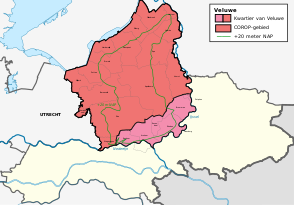Veluwe
Veluwe | |
|---|---|
Region | |
| Area | |
| • Total | 912 km2(352 sq mi) |
| Population (2023) | |
| • Total | 715,729 |
| Website | www |


TheVeluwe(Dutch pronunciation:[ˈveːlyʋə]) is a forest-rich ridge of hills (1100 km2;420 sq. mi.) in the province ofGelderlandin theNetherlands.The Veluwe features many different landscapes, includingwoodland,heath,some small lakes and Europe's largest sand drifts.
The Veluwe is the largestpush morainecomplex in the Netherlands, stretching 60 km (40 miles) from north to south, and reaching heights of up to 110 metres (360'). The Veluwe was formed by the Saalian glacial during thePleistoceneepoch,some 200,000 years ago. Glaciers some 200 metres (600') thick pushed the sand deposits in the Rhine and Maas Delta sideways, creating the hills which now form most of the Veluwe. Because the hills are made of sand, rain water disappears rapidly, and then it flows at a depth of tens of metres (yards) to the edges where it reaches the surface again.[1]
Originally the Veluwe was surrounded by a string of swamps, heavily populated withgamesuch asdeerandwild boarbecause these areas offered rich vegetation to feed on. Since the 1990s many plans are underway, or have already been implemented, to restore these wetlands by blocking the drainage systems built by farmers during the last 150 years. This results in very dry heathland changing into wetland within a span of just a few hundred metres (yards). TheWisselse Veennear the village ofEpe,on the northeastern Veluwe, offers a good example of this.[citation needed]
Etymology
[edit]Veluwe derives from Proto-Germanic *falwaz(pale, fallow) and *awjō(island).[2]The name corresponds to "fallow lands" in English and probably was used in opposition to the fertile "good lands" of theBetuwe(from *bataz,good, and *awjō,island) to the south.
Geography
[edit]
There are 21 municipalities in the Veluwe region:Apeldoorn,Arnhem,Barneveld,Brummen,Ede,Elburg,Epe,Ermelo,Harderwijk,Hattem,Heerde,Nijkerk,Nunspeet,Oldebroek,Putten,Renkum,Rheden,Rozendaal,Scherpenzeel,VoorstandWageningen.
The sparsely populated, infertile Veluwe acts as the traditional linguistic boundary betweenLow Franconiandialects (i.e. essentially Dutch and closely related dialects) to the west and south andLow Saxondialects further north and east.[3]
Flora and fauna
[edit]
There are bothconiferousanddeciduousforests on the Veluwe, and some 500 different plant species can be found. The region is also home to many different species of animals, such aswild boar,several species of deer (like theroe deer,red deerandfallow deer), several species ofsnakes(including thecommon viper),pine martens,foxes,andbadgers.Furthermore, the birdravenwas successfully reintroduced, and the introducedReeves's muntjacandmoufloncan sometimes be seen. Furthermore, there live semi-wild and wild cattle and horses like both semi-wild and wildHighland cattlein multiple areas of the Veluwe, semi-wildSayaguesa cattleand two semi-wild horse breeds:New-forest ponyandIcelandic pony.Since 2019 thewolfis officially back with a female and male pair in the northern Veluwe (spring 2019) who had their offspring in the summer of 2019 and one female wolf in middle Veluwe. The prognosis are that many more wolves will reclaim the area. TheEuropean bisonis also reintroduced as pilot in a fenced area in theRadio Kootwijk Reserveand thegolden jackalis reaching the area, from which they are not native, but since the jackals reach the area all by their own they are seen as a welcome and new native species.
Developments
[edit]Parts of the Veluwe that have been separated from each other by roads, towns and farmland are being reconnected by returning farmland to nature and creatingwildlife crossingsover highways. In 2012, nine of these overpasses had been built, each one about 50 metres (200') wide and covered with sand and vegetation to encourage animals to use it.[4]Wildlife corridorsconnecting the Veluwe to other wildlife areas such as theOostvaardersplassenin the Netherlands are being developed and further connections to Germany are an option.[5]It is hoped that by doing so thegenetic diversityof the wildlife population will increase.
In order to turn the entire Veluwe into oneIUCN(Category II) standardNational Parka number of actions have been taken, or are planned, including: bungalow parks located in a more sensitive natural area have been removed; taking down remaining fences, as aroundDe Hoge Veluwe;an old industrial zone near the village ofRenkumwas cleared away because it blocked a valley that was important for the migration of wildlife; and a military complex nearNunspeetwas removed instead of being redeveloped as a business area.[citation needed]
Tourism and recreation
[edit]
The Veluwe is a tourist destination, especially for Dutch people wanting to go on a short vacation in their own country.Campsitesandbungalowparks are the preferred place to stay for most visitors.[citation needed]There are more than 500 of these sites, most located on the outskirts of the natural area.
Tourist attractions in the area include four zoos, over 50 museums including theKröller-Müller art museum,and the royal palaceHet LooatApeldoorn.TheNational Sports Centre Papendal,a large sports complex andOlympic Gamestraining facility, is located in the south of the Veluwe nearArnhem.
References
[edit]- ^Martens, Anne (April 30, 2008)."Stuwwal".Geologie van Nederland.Geologie van Nederland.RetrievedDecember 5,2019.
- ^Nederlands Etymologisch Woordenboek - J. de Vries
- ^Confer these maps:https://en.wikipedia.org/wiki/Low_Franconian#/media/File:Niederfr%C3%A4nkisch.pngandhttps://de.wikipedia.org/wiki/Westf%C3%A4lische_Dialekte#/media/Datei:Dialekte_in_Nordrhein-Westfalen.PNG
- ^(in Dutch)Province of Gelderland, factsheet wildlife crossings
- ^L. Verbeek; A.E. Bliek-de Jong (October 2010)."Oostvaardersland. Strengthening biodiversity and the economy in the Netherlands"(PDF).Presentation at the Convention on Biological Diversity, Nagoya, Japan. Archived fromthe original(PDF)on 17 October 2014.Retrieved20 August2013.
External links
[edit]- Veluwe Tourist Information(in English)



